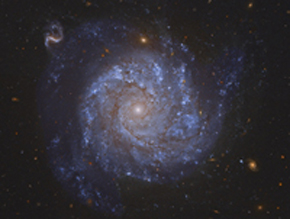

Researchers from the Universidade de São Paulo begin project to study the types and amounts of metals present in the gases surrounding groups of galaxies(NASA)
Researchers from the Universidade de São Paulo begin project to study the types and amounts of metals present in the gases surrounding groups of galaxies
Researchers from the Universidade de São Paulo begin project to study the types and amounts of metals present in the gases surrounding groups of galaxies

Researchers from the Universidade de São Paulo begin project to study the types and amounts of metals present in the gases surrounding groups of galaxies(NASA)
By Elton Alisson
Agência FAPESP – In addition to hydrogen and helium, other chemical elements in the Universe, including oxygen, carbon, iron and lithium, form a set generically referred to as metals by astrophysicists.
If scientists study the types and amounts of these elements present in the gas surrounding galaxies—the metallicity of the gas—it is possible to estimate how these elements evolved.
A group of researchers at the Universidade de São Paulo’s Institute of Astronomy, Geophysics and Atmospheric Sciences (IAG-USP) has begun a research project with FAPESP funding to study the metallicity of galaxy clusters (a group of many galaxies).
“When we better understand the production and transfer processes involving chemical elements that occur inside these objects, which are the largest-scale balanced objects in the Universe, it will be possible to fill in a large gap in the puzzle and to understand the chemical evolution of space as a whole,” said Gastão Cesar Bierrenbach Lima Neto, professor at IAG and coordinator of the project, to Agência FAPESP.
According to the researcher, with the exception of hydrogen, helium and lithium, all the metallic elements present in the Universe are produced by stars (during a process called stellar nucleosynthesis), which then, in turn, form galaxies.
As stars evolve, they eject these metals into the galactic interstellar medium, where the material is recycled and can eventually generate new stars.
As these are highly complex processes, numerical simulations must be conducted on supercomputers to study the metallicity of galaxies. “We have to use very large computers as well as complex codes and a team of researchers,” explained Lima Neto.
Additionally, X-ray observations are necessary and will be conducted by Lima Neto and researcher Tatiana Ferraz Laganá during the project. Laganá is doing her post-doctoral research at the Universidade Cruzeiro do Sul Theoretical Astrophysics Nucleus (NAT-UNICSUL) as part of FAPESP’s Young Researchers Program. “X-rays show us the composition of the gas located between galaxies, and this gas is enriched by the galaxies,” explained Lima Neto.
New computer cluster
To perform their numerical simulations, the IAG researchers use one of the largest and strongest clusters (group of computers) exclusively used for astronomical research. It was installed at the Department of Astronomy at the beginning of 2012.
Valued at more than US$ 1 million, the equipment was acquired with FAPESP funding through the Multiuser Equipment Program as part of a project underway at IAG in partnership with UNICSUL’s NAT.
Composed of three towers the size of home refrigerators weighing a total of three tons, the group of computers has 2,300 processing cores.
The system increased the USP Astronomy Department’s processing capacity by a factor of 60. The previous cluster used by the institution had 40 cores.
“The new cluster contributed substantial calculating power for our numerical simulations,” evaluated Lima Neto. “Simulations that previously took months can now be completed in a few days.”
Researcher Rubens Eduardo Garcia Machado, with post-doctoral research at IAG through a FAPESP scholarship, has begun to run the first numerical simulations of collisions of galaxy clusters. Such collisions also drive changes in the chemical composition of the galaxies.
Through collaborations with colleagues in other South American nations, the IAG researchers also intend to adapt numerical simulation codes for chemical evolution.
The Brazilian scientists have begun dialogue in recent years with their colleagues at the National Science and Technical Research Council’s Institute of Astronomy and Space Physics (IAFE-COINCET) in Argentina and the Universidade de Buenos Aires (UBA) to establish formal collaborative research.
Republish
The Agency FAPESP licenses news via Creative Commons (CC-BY-NC-ND) so that they can be republished free of charge and in a simple way by other digital or printed vehicles. Agência FAPESP must be credited as the source of the content being republished and the name of the reporter (if any) must be attributed. Using the HMTL button below allows compliance with these rules, detailed in Digital Republishing Policy FAPESP.





